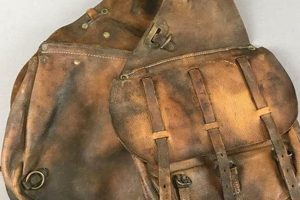These sought-after accessories represent a specific era in American leather goods production. Characterized by their durable construction, simple designs, and use of high-quality materials like full-grain leather, these items were emblematic of functional luxury. A defining characteristic is often the presence of a classic brass turnlock closure and minimalist hardware.
The appeal stems from their enduring style and the narrative they embody. They offer a tangible connection to the past, representing a time when quality craftsmanship and lasting value were paramount. Owning one provides access to a piece of design history and a sustainable alternative to contemporary mass-produced goods. The robust construction ensures longevity, allowing for continued use and appreciation.
Subsequent sections will delve into specific models, identifying key characteristics and offering guidance on authentication and care. Understanding the nuances of these items empowers informed acquisition and preservation of these vintage treasures.
Tips for Acquiring and Maintaining 1970s Coach Handbags
The acquisition and preservation of Coach handbags from the 1970s requires careful consideration. This section provides practical guidance to ensure authenticity, quality, and long-term enjoyment of these vintage items.
Tip 1: Verify Authenticity: Examine the creed stamp inside the bag. It should be clear and precisely aligned. Inconsistencies in font or spacing may indicate a replica.
Tip 2: Assess Leather Quality: Authentic models from this era utilize full-grain leather. Inspect for natural variations, such as wrinkles and scars, which are characteristic of genuine leather. Avoid items where the leather appears overly smooth or uniform, as this may indicate corrected grain or synthetic materials.
Tip 3: Inspect Hardware: Original hardware, including turnlocks and zippers, should be solid brass. Examine for signs of corrosion or damage. Replacement hardware is common but can detract from the item’s value.
Tip 4: Evaluate Stitching: Consistent, even stitching is a hallmark of quality craftsmanship. Look for loose threads, irregular spacing, or evidence of repair. Poor stitching can compromise the bag’s structural integrity.
Tip 5: Check Lining (if applicable): Some models feature a fabric lining. Examine the lining for tears, stains, or odors. A damaged lining may require professional restoration.
Tip 6: Consider the Odor: A musty or unpleasant odor can be difficult to remove. Thorough cleaning and airing may be necessary. Severe odors can indicate mold or water damage, potentially affecting the item’s value and usability.
Tip 7: Research Specific Models: Familiarize yourself with popular models from the 1970s, such as the Dinky or the Shoulder Bag. Understanding the specific features and characteristics of each model will aid in identifying authentic examples.
Adhering to these guidelines will assist in making informed decisions and ensure the long-term preservation of these historically significant accessories.
The subsequent sections will address cleaning and storage methods to maintain the condition of vintage Coach handbags.
1. Craftsmanship
Craftsmanship is a central tenet of vintage Coach bags from the 1970s. The quality of construction is directly linked to the longevity and aesthetic appeal of these items. Specifically, the use of full-grain leather, carefully selected for its durability and natural characteristics, exemplifies this. Each piece was meticulously cut and sewn, with attention paid to ensuring structural integrity at stress points. The result is an accessory built to withstand daily use and aging gracefully. For instance, the precise stitching around the handles and along the seams of a classic Dinky bag showcases a commitment to detail that contributes to its continued functionality decades later.
Further analysis reveals that the emphasis on craftsmanship extends beyond the selection of materials. The construction methods employed, such as the use of reinforced stitching and meticulously applied hardware, reflect a dedication to producing a superior product. Consider the solid brass turnlocks found on many styles; these were not merely decorative elements but integral components designed for repeated use. The enduring functionality of these original features serves as tangible evidence of the superior workmanship. Understanding these details allows collectors and enthusiasts to discern genuine vintage pieces from later reproductions or imitations.
The enduring value of vintage Coach bags from this period is intrinsically linked to the dedication to quality craftsmanship. While the aesthetics are undeniably appealing, it is the underlying construction and attention to detail that ensure their continued desirability. The challenge for modern consumers lies in recognizing and appreciating these nuances when assessing a potential purchase. Ultimately, recognizing the craftsmanship inherent in these items enables informed decisions, promoting the preservation and appreciation of these pieces of design history.
2. Full-grain Leather
The utilization of full-grain leather is a defining characteristic that separates vintage Coach bags from the 1970s from many contemporary counterparts. This specific type of leather, derived from the uppermost layer of the hide, retains the natural grain pattern and inherent imperfections. As a result, items crafted from full-grain leather exhibit unique textures and develop a rich patina over time. The selection of this material directly impacts the durability and aesthetic longevity of these bags. For example, a well-maintained Coach Dinky from this era, crafted from full-grain leather, retains its shape and exhibits a suppleness that belies its age, demonstrating the inherent qualities of the material.
Furthermore, the use of full-grain leather in these vintage accessories is not merely a superficial design choice. It represents a commitment to quality and longevity. Unlike corrected-grain or genuine leather, full-grain leather possesses a tightly woven fiber structure, affording it superior resistance to tearing and abrasion. The natural oils present within the leather act as a protective barrier, preventing it from drying out and cracking. Consequently, a Coach bag from the 1970s, properly cared for, can endure decades of use, becoming an heirloom piece that embodies both functionality and enduring style.
In summary, the association between full-grain leather and vintage Coach bags of the 1970s is inextricably linked to the superior quality and enduring appeal of these items. The understanding of this connection allows discerning buyers to identify authentic pieces and appreciate the value proposition inherent in owning an accessory crafted from a material that not only enhances the aesthetic but also guarantees long-term durability. The challenge lies in educating consumers to recognize the difference between full-grain leather and its lower-quality counterparts, fostering a greater appreciation for the craftsmanship and materials that define this era of Coach handbags.
3. Minimalist Design
The aesthetic restraint of minimalist design profoundly influenced the creation and appeal of vintage Coach bags from the 1970s. Characterized by a deliberate absence of excessive ornamentation and a focus on functional form, this design philosophy permeated every aspect of their construction.
- Unadorned Silhouettes
The overall shape of these bags prioritized simplicity and practicality. Eschewing elaborate embellishments, designs featured clean lines and geometric forms. A classic example is the Coach Dinky, which relied on its rectangular shape and understated turnlock closure to convey elegance. The deliberate absence of superfluous details highlighted the quality of the leather and the craftsmanship involved.
- Functional Hardware
Hardware elements, such as buckles, zippers, and turnlocks, were integrated seamlessly into the design, serving a practical purpose without drawing undue attention. The solid brass hardware, commonly found on these bags, was chosen for its durability and understated aesthetic, complementing the overall minimalist design. A turnlock closure, for example, was not just a fastening mechanism but also a subtle design feature that enhanced the bag’s functionality and visual appeal.
- Monochromatic Palette
Color choices typically remained within a limited range of neutral tones, such as black, brown, and tan. This deliberate restraint in color selection reinforced the minimalist aesthetic and allowed the inherent beauty of the leather to take center stage. The absence of vibrant or contrasting colors contributed to the bags’ timeless quality and versatility, enabling them to complement a wide range of outfits and personal styles.
- Emphasis on Quality Materials
Minimalist design inherently emphasizes the quality of the materials used. With fewer decorative elements to distract the eye, the texture and grain of the full-grain leather became a focal point. The high-quality leather was not merely a functional component but a crucial element in conveying a sense of understated luxury and enduring value. The inherent characteristics of the leather, such as its natural variations and ability to develop a patina over time, were embraced as integral aspects of the design.
These facets of minimalist design, carefully integrated into the construction of vintage Coach bags from the 1970s, contributed to their enduring appeal and timeless aesthetic. The focus on functional form, understated hardware, and high-quality materials resulted in accessories that were both practical and elegant. The sustained popularity of these bags demonstrates the enduring power of minimalist design and its ability to transcend fleeting trends.
4. Brass Hardware
The incorporation of solid brass hardware is a defining characteristic of Coach bags produced during the 1970s. This choice of material was not merely aesthetic; it reflected a commitment to durability and lasting value, aligning with the brand’s design ethos of the time. The hardware served both functional and aesthetic purposes, contributing significantly to the overall appeal and longevity of these vintage accessories.
- Turnlock Closures
The iconic Coach turnlock closure, typically crafted from solid brass, served as a secure and visually distinctive fastening mechanism. Its robust construction ensured years of reliable use, while its simple design complemented the minimalist aesthetic of the bags. For example, the brass turnlock on a vintage Coach Dinky bag not only secured the contents but also served as a subtle focal point, enhancing the bag’s overall elegance. The tarnishing of the brass over time often added to the character and vintage appeal of the piece.
- Buckles and Rings
Brass buckles and rings were commonly employed for strap adjustments and attachments. These components were chosen for their strength and resistance to corrosion, ensuring that the straps remained securely fastened and adjustable throughout the bag’s lifespan. A vintage Coach Shoulder Bag, for instance, featured solid brass buckles that allowed the wearer to customize the strap length for optimal comfort. The durability of the brass ensured that these adjustment points remained functional even after decades of use.
- Zippers and Pulls
While less prevalent than turnlocks, brass zippers and pulls were used in certain Coach bag models from the 1970s. These components offered a secure and reliable closure option, particularly for larger compartments. The brass construction ensured smooth operation and resistance to breakage. A vintage Coach Satchel, for example, might have featured a brass zipper closure that provided easy access to the bag’s main compartment while maintaining a secure seal. The weight and feel of the brass zipper pull contributed to the overall sense of quality.
- Rivets and Fasteners
Brass rivets and fasteners were used to reinforce stress points and secure seams. These small but crucial components added to the overall structural integrity of the bags, preventing tearing and extending their lifespan. On a vintage Coach City Bag, for example, brass rivets might have been used to reinforce the handle attachments, ensuring that the handles remained securely fastened even when the bag was heavily loaded. These small details highlight the attention to detail and commitment to durability that characterized Coach bags of the 1970s.
The consistent use of solid brass hardware across various Coach bag models from the 1970s is a testament to the brand’s commitment to quality and durability. These components not only enhanced the functionality and aesthetic appeal of the bags but also contributed to their lasting value and vintage charm. The enduring presence of these brass elements serves as a tangible reminder of the craftsmanship and design principles that defined this era of Coach production.
5. Durability
The durability of Coach bags manufactured in the 1970s stands as a primary reason for their continued desirability. This attribute stems directly from the utilization of high-quality, full-grain leather and the implementation of robust construction techniques. The leather’s inherent strength, coupled with meticulous stitching and the strategic placement of solid brass hardware, creates an accessory capable of withstanding decades of use. A vintage Coach bag, properly maintained, frequently demonstrates resilience that surpasses many contemporary mass-produced equivalents. Consider, for example, a well-preserved Coach City Bag from this era; its ability to carry substantial weight without exhibiting significant wear or tear is a testament to its durable construction.
Further examination reveals specific factors contributing to this resilience. The use of saddle stitching, a technique that employs two needles and creates a lock stitch, prevents unraveling even if a thread breaks. Brass rivets reinforce stress points, such as handle attachments, minimizing the risk of failure under load. The thickness of the full-grain leather provides resistance to abrasion and punctures. This combination of material quality and construction methodology ensured that these bags were not merely fashionable accessories but also practical and reliable tools. The longevity of these bags has practical significance; it translates into a sustainable alternative to frequently replacing lesser-quality items. Individuals can acquire a vintage piece that offers both style and lasting utility.
In conclusion, the durability of vintage Coach bags from the 1970s is a defining characteristic directly attributable to the selection of superior materials and the application of skilled craftsmanship. This inherent strength provides practical benefits, enabling these bags to withstand the test of time and offering a sustainable alternative to modern accessories. The appreciation of this durability is essential for those seeking to acquire a piece of design history that combines both aesthetic appeal and long-lasting functionality.
6. Timeless Style
The enduring appeal of Coach bags from the 1970s is inextricably linked to their embodiment of timeless style. This characteristic transcends fleeting trends, securing their relevance across generations and solidifying their status as enduring classics. The consistent aesthetic principles employed during this era account for this lasting appeal.
- Classic Silhouettes
The silhouettes favored during this period prioritized simple, functional forms. Designs such as the Dinky and the Shoulder Bag eschewed overly embellished shapes in favor of clean lines and practical dimensions. The absence of transient design elements ensured that these bags remained relevant irrespective of prevailing fashion currents. The enduring popularity of these silhouettes demonstrates their ability to adapt to diverse personal styles.
- Enduring Materials
The use of full-grain leather, selected for its durability and natural aesthetic, contributes significantly to the timeless style. Unlike synthetic materials, full-grain leather develops a patina over time, enhancing its character and visual appeal. This aging process imbues each bag with a unique quality, further distancing it from the fleeting trends of mass-produced accessories. The tactile qualities of the leather contribute to the bag’s lasting appeal.
- Restrained Hardware
The implementation of solid brass hardware, often in the form of turnlocks and buckles, adds to the timeless quality. These components are not only functional but also contribute to the understated elegance of the bags. The subtle sheen of the brass complements the leather’s texture, creating a harmonious balance. The choice of brass, a material known for its durability, reinforces the enduring nature of these accessories.
- Versatile Color Palettes
Color schemes typically adhered to neutral tones, such as black, brown, and tan. This restrained palette ensured that the bags remained versatile and adaptable to a wide range of outfits and occasions. The absence of bold or trend-driven colors contributes to their timeless appeal. These neutral tones allow the bags to seamlessly integrate into diverse wardrobes, solidifying their status as enduring wardrobe staples.
The confluence of these factors classic silhouettes, enduring materials, restrained hardware, and versatile color palettes collectively defines the timeless style associated with Coach bags from the 1970s. The enduring popularity of these bags serves as a testament to the enduring power of classic design principles and their ability to transcend fleeting trends. The ability to maintain relevance across decades is a hallmark of true timelessness.
7. American Heritage
Coach bags from the 1970s are not merely fashion accessories; they represent a tangible link to American heritage. The brand’s history is interwoven with the evolution of American manufacturing and design sensibilities. The materials used, such as full-grain leather sourced domestically, and the production processes employed during that era reflect a commitment to quality and craftsmanship that was characteristic of American industry. The practical effect of this is that these bags embody a period when American-made goods were synonymous with durability and lasting value. The iconic designs, often inspired by equestrian traditions and utilitarian forms, further solidify their connection to a specific chapter in American cultural history.
The importance of “American Heritage” as a component of these accessories lies in its ability to evoke a sense of nostalgia and authenticity. Owning a vintage Coach bag from the 1970s offers a connection to a time when products were built to last and craftsmanship was highly valued. For example, the use of solid brass hardware, meticulously applied, contrasts sharply with the mass-produced alternatives often found in contemporary accessories. This level of detail, combined with the inherent qualities of the leather, creates a unique sense of heritage. Understanding this connection allows individuals to appreciate the cultural significance and historical value of these items, transforming them from mere possessions into objects of cultural preservation.
In conclusion, vintage Coach bags from the 1970s serve as potent symbols of American heritage, representing a period of quality craftsmanship and design integrity. Recognizing this connection allows for a deeper appreciation of their intrinsic value, extending beyond their aesthetic appeal. The challenge lies in preserving these items and educating future generations about their significance in the context of American manufacturing history.
Frequently Asked Questions
The following addresses common inquiries regarding Coach bags manufactured during the 1970s, offering detailed insights into their characteristics, acquisition, and care.
Question 1: How can the authenticity of a Coach bag from the 1970s be verified?
Authenticity can be assessed by examining the creed stamp located inside the bag. The creed should be clearly legible, with consistent font and spacing. Furthermore, the serial number, if present, should correspond to known formats for that era. Discrepancies in the creed or serial number may indicate a counterfeit.
Question 2: What are the key differences between full-grain leather and other types of leather used in Coach bags?
Full-grain leather, derived from the uppermost layer of the hide, retains its natural grain and imperfections. This type of leather is more durable and develops a patina over time. Lower-quality leathers, such as corrected-grain or genuine leather, undergo processes that remove the natural grain, resulting in a less durable and less aesthetically appealing product.
Question 3: Is it possible to restore a vintage Coach bag with significant wear and tear?
Restoration is possible, but the extent of restoration depends on the severity of the damage. Professional leather restoration services can repair tears, clean stains, and replace hardware. However, excessive restoration can diminish the bag’s originality and value.
Question 4: What are the recommended methods for cleaning a Coach bag from the 1970s?
Cleaning should be performed with care, using a soft cloth and a mild leather cleaner specifically designed for vintage items. Harsh chemicals or abrasive cleaners should be avoided, as they can damage the leather. A professional leather cleaner is recommended for significant soiling.
Question 5: How should vintage Coach bags be stored to prevent damage?
Storage should occur in a cool, dry place, away from direct sunlight. Stuffing the bag with acid-free tissue paper helps maintain its shape. Storing the bag in a dust bag protects it from scratches and dust accumulation. Avoid storing in plastic, as it can trap moisture and lead to mold growth.
Question 6: Does the presence of a specific model number guarantee authenticity?
While model numbers can provide clues to authenticity, they do not guarantee it. Counterfeiters often replicate model numbers. A thorough examination of the creed stamp, leather quality, and hardware is necessary to determine authenticity definitively.
These answers provide clarification on essential aspects of owning and caring for vintage Coach bags from the 1970s. Understanding these details is crucial for making informed decisions and preserving these valuable accessories.
The subsequent sections will focus on identifying specific models and their distinguishing features.
Conclusion
The preceding analysis has underscored the multifaceted significance of vintage coach bags 1970s. The investigation highlighted the superior craftsmanship, the use of durable full-grain leather, the minimalist design principles, and the robust brass hardware that characterized this era of Coach production. Furthermore, the discussion emphasized the timeless style and the representation of American heritage embodied within these accessories.
These vintage items represent a convergence of quality materials, meticulous construction, and enduring design. Preserving these bags is crucial for maintaining a tangible connection to a significant period in American manufacturing history. Continued research and informed stewardship are essential to ensuring their appreciation by future generations.







